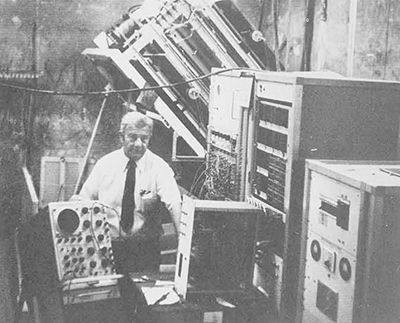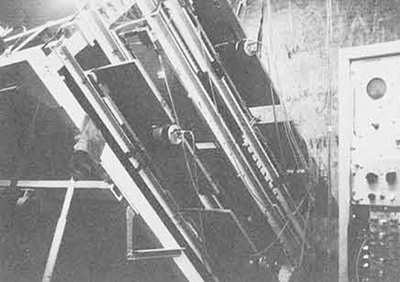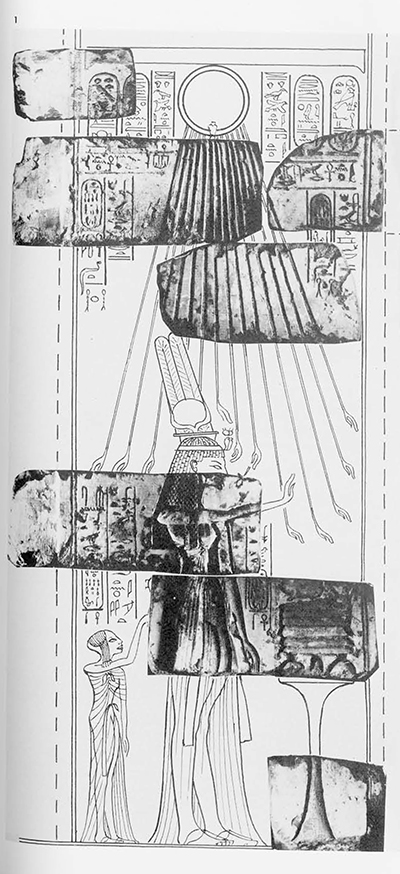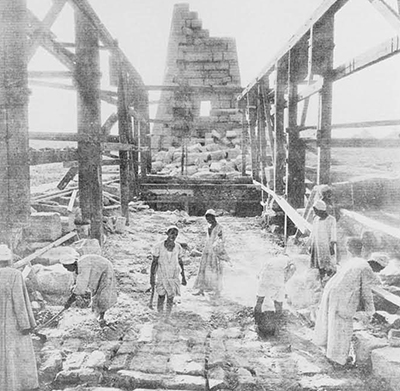
Two of the most interesting archaeological ventures now being conducted in Egypt illustrate at its most dramatic the application of modern science and technology to the problems of antiquity. Their common denominator is the use of computers, the best instrument, if not the only one, to handle the enormous dimensions of both projects. One is the biggest jigsaw puzzle in the world, the other the biggest “X-ray examination”—in both cases, bigger by a factor of a million or so than anything of the sort ever attempted.
The developments of twentieth century archaeology have accustomed us, almost to the point of yawns, to seeing science in its service in the glamorous role of discoverer (magnetometers, infra-red photography, for instance), ex post facto medical diagnostician, chronology detector (carbon-14, thermoluminescence), retroactive weather reporter (fossilized pollen, dendrochronology) and in a dozen other sophisticated functions. In the two Egyptian inquiries, however, the computer is called into play as a drudge, but that is what it does best; it is reduced, if you will, to the humble role of file clerk, but exalted in that service to a veritable prodigy of a file clerk, with elephantine memory, instant recall, total space perception and mathematical transcendence.

In the mid-1960’s Nobelist Luis Alvarez conceived the audacious notion of exploring the interior of the pyramid of Chephren (Herodotus’ name for Khafre, which has persisted in common Western usage), about 2589-2566 B.C., standing next to the Great Pyramid of Cheops (Khufu) and only slightly smaller. The purpose was to discover whether it contains, as does the Great Pyramid, a complex of hitherto undiscovered chambers and passages.
Only two corridors, joining in a vertical fork, and two chambers are known in the Chephren pyramid, discovered in 1816 by the Italian explorer Belzoni. Why, asked the famous cosmic ray scientist at the University of California, should Chephren have settled for a relatively uninteresting pile of almost solid limestone when the huge mortuary monuments of his father Cheops and son Mycerinus (Menkaure) a few yards distant were constructed with many passages and rooms? If there are other chambers in Chephren’s monument that escaped the inevitable grave robbers (who tunneled through to the Pharoah’s tomb probably soon after his death, but whose tunnel was itself lost to the ages) they are presumably intact; they would be a prize more valuable—being much older —than Tutankhamun’s tomb.
It must be noted at the outset that most Egyptologists believe that Alvarez cherished a vain hope, and that no further chambers exist. They argue that over the almost five millennia since the early Pharoahs of the IVth Dynasty, grave robbers have searched and snooped, tapped every likely stone for a telltale hollow sound behind it; if there were anything there they would have found it.
Dr. Alvarez chose to end speculation once and for all by employing a method analogous to X-ray photography. The technique is nothing more than measuring the density intervening between a radiation source and sensitized recorders. The denser the material, the more the radiation is blocked.
Soft X-rays, obviously, cannot penetrate stone, much less millions of tons of it, but other radiation particles can, notably one of the collision products of the constant bombardment of the earth by cosmic rays. This particle, the mu meson or muon, an electrically charged fragment of an atomic nucleus about one-fifth the weight of the hydrogen atom, is born when a cosmic ray splits an atom in the earth’s outer atmosphere. Traveling at about one-tenth the speed of light, scores of muons strike every square yard of the earth’s surface every second. In their plunging course, some are stopped by intervening obstacles early, others late or never; a few are stopped by the stone in the pyramid, some penetrate to recorders placed in Chephren’s burial chamber, at the base and almost dead-center of the pyramid.
The recorder (or counter) is a standard, if infinitely complex and sophisticated, laboratory device consisting of a weave of thousands of tiny wires, 1 mm. in diameter and 1 mm. apart, forming a mesh, the whole sealed in a chamber of gas. If a muon enters the chamber, its electric charge ionizes the gas, sets up an electric potential in it, and a spark on a wire ensues at that spot.
In a joint Egyptian-American project, supported by the National Science Foundation, a double-deck spark chamber was installed in 1967 in the burial chamber. It was no mean feat, for much of the entrance passage is only four feet square, necessitating a tedious crouch on the part of anyone traversing it; the spark chamber and counting devices weigh some 35 tons.
The two-layer chamber of counters, each segment about five feet square and mounted one a few inches above the other, locates the angle of entrance of muons coming through the walls of the pyramid (several every second although the machine is capable of recording only about one or two per second). As the muon enters the top chamber, the resulting spark marks the exact spot. A fraction of a microsecond later it does the same thing in the lower chamber. The difference between the two impact locations reveals the angle at which the muon was traveling. The data are fed automatically onto a recording tape, which in turn is put through a computer at in Cairo, manned and interpreted by young graduates. If a significantly larger number of “events” is recorded from one direction, the deduction is that there was less of an obstacle for the muons to traverse—less stone to intercept them—along that particular course. Ergo, a hole, an empty spot, a room.
The equipment was initially operated for about a year, facing directly upward and scanning a cone-shaped segment in the pyramid over an arc of about 36°. No discrepancy in the number of penetrating muons (taking into account the volume of stone being traversed at each point) was found, indicating that the section scanned was uniform with no cavities therein. There was nothing amiss with the equipment. From the computer tallies, the analysts were able to verify exactly the known height of the pinnacle of the pyramid and to demonstrate that the burial chamber below was 3° off the vertical from the peak.
But if there are, in fact, other chambers. In the great structure, they are thought more likely to be in the sides than directly above the burial room. Consequently, after the experiment was shut down for four years, it was started anew in November, 1972, with the spark chamber so arranged as to permit its rotation to scan all four sides of the pyramid, one after the other, each for several months, to obtain the requisite number of “events”— a million or two—for valid comparisons.
Nicholas Chakakis, an engineer who is one of Dr. Alvarez’s co-workers and enthusiasts, is in charge of the operation. He is properly close-lipped about what the results have been so far. But a visitor does not get the impression from him or other professionals on the project that they are bubbling over with suppressed excitement.
Of the many attempts in history deliberately to reduce a person to a non-person—that concerning Nicholas Chakakis being merely the most recent—none was more determined and extensive than that having to do with Akhenaten. Determined, because his successors resolved to blot his name and his works from the memory of man; extensive, because the apostate Pharaoh, whom Breasted called “the first individual in history,” was a prodigious builder and consequently his nonpersonifiers had a prodigious lot to destroy. That they were spectacularly successful is evidenced by the fact that although Akhenaten is known to have had built a number of vast structures during his 16-year reign, the exact location of none of them is known today. The Romans who leveled Carthage could not have done better than the extirpators of the Great Heresy.
Nevertheless, such is the indestructibility of the stone hewn from the Egyptian quarries, some pieces remain. Indeed, of the Pharaoh’s enormous temples at Karnak, some 35,000 decorated pieces remain: ashlar blocks, most of about 54 x 24 x 20 cm., splendidly incised and painted. There also remain many undecorated blocks. When the gigantic buildings were destroyed soon after Akhenaten’s death, the stones were re-used, principally as fill for at least three of the ten monumental pylons at Karnak erected by later Pharaohs. Thereby, two purposes of those restorers of religious orthodoxy were served: the blocks, neatly cut and dressed in uniform sizes, made ideal building material and, as fill, the engraved and painted heresies were successfully hidden from view, deep inside the two-meter thick walls of the pylons.
But what they achieved at the time, today’s archaeologists are in some measure able to undo. Two major attempts to “reconstruct” the Akhenaten solar temple at Karnak are now in full swing. The aim of both is to recompose the thousands of stones into their original scenic designs—not physically or literally except for a few showpieces—but by matching thumb-nail size photographs of the blocks and thus reassembling pictorially the composition and its historical, descriptive, religious and artistic entity.

Akhenaten was initially titled Amenophis IV, one of the later Pharaohs of the glorious XVIIIth Dynasty, co-regent with his father Amenophis III from about 1378 B.C. until the latter’s death in 1367 and then, adopting a new name to conform with his new religion, ruler until 1362. He came to power when Egypt’s sway extended—by alliances, vassal kings and viceroys—through the Northern Sudan, Palestine, Syria and far into Upper Mesopotamia. On his death and the accession of his son-in-law, Tutankhamun, imperial control was severely weakened. Akhenaten, it would seem, let his religious obsession displace political imperatives.
His most recent biographer, the eminent British Egyptologist Cyril Aldred, sees Akhenaten as a less revolutionary figure than have most earlier scholars, finding his identification of himself with his deity, Aten, not unprecedented: Pharoahs of more ancient dynasties had done as much. His replacement of the dominant god of Egypt, Amun, the sun, with Aten, the sun-disk, was also not a totally unnatural step.
But what began with Akhenaten’s studied ignoring of other gods in the huge Egyptian pantheon developed later in his reign into the principal element of the Great Heresy: the virulent suppression of the other objects of worship and the insistence on Aten as the one and only deity. This was unique and unprecedented, the first Egyptian monotheism, preceding that of Moses, although certainly not monotheism in anything like the Judeo-Christian-Islamic sense.
It has long been taken for granted that in suppressing the worship of other gods and particularly of Amun, Akhenaten provoked furious religious warfare, led by Amun’s now denigrated priests, and that on his death it was they who set about eradicating his memory and mention, his name and his works, and restoring the orthodoxy quo ante. Mr. Aldred believes matters were not all that simple, and that it may have been the Ramessides of the XIXth Dynasty who were more responsible for wrecking Akhenaten’s new capital at Tell el-Amarna and his temples, and for chiseling off his name wherever it was found, than was the man conventionally credited with the job, Horemhab, last Pharoah of the XVIIIth Dynasty.
But one aspect of Akhenaten’s rule and times admits of no doubts or disputation: during his period Egyptian art underwent a revolutionary change. The rigid, conventional style, with the idealized representation of every Pharoah worshipping like every other gave way to much more freedom in style, to more realism and even expressionism, and to individualistic portraits. What is perhaps even more remarkable than the famous bust of Akhenaten’s queen, Nefertiti, as a living, breathing beauty is the representation of Akhenaten himself as an ugly man with a receding forehead, long nose, pendulous oversized jaw, ponderous belly, fat buttocks and thighs and spindly shanks. These attributes, plus a monstrously elongated skull and the fact that on one statue he is shown with no genitalia whatsoever, have led to a general conclusion that he suffered a serious endocrine imbalance. One frieze and some hieroglyphic evidence suggest that he was a homosexual.
What makes the recovery of the decorated blocks of the Karnak temple doubly interesting is that they show unmistakably this departure from the conventional, millennia-long, Egyptian art style. They reflect and perhaps antedate the change seen so abundantly in the finds at the king’s new capital, built from scratch, at Amarna.
The Karnak blocks were first brought to light by the French archaeologist, Henri Chevrier, in 1926, when restoring post-Akhenaten monuments. Thousands more were uncovered during the next three decades. (They are commonly known as talatat, a word that means, collectively, “threes” in Egyptian Arabic; theories about the etymology are varied and inconclusive.) With the passage of time they were widely dispersed, some even in European and American collections, but most were placed in storage depots in Karnak. If there had been any system in their original depositions as fill and in their removals it had long since been dissipated. Their juxtapositions in the warehouses were helter-skelter.
It was in 1965, almost forty years after the first discovery, that a retired American businessman, Ray Winfield Smith, conceived the grandiose project of reassembling them—on paper, photographically. Contemplating some 16,000 blocks (later increasing to about 25,000), each to be photographed individually and thereupon to be matched, Smith concluded that only by means of acomputer, codifying information about the pictorial contents of each block, could the job be attempted. He presented his idea to the University Museum of the University of Pennsylvania which agreed to sponsor it. The resulting Akhenaten Temple Project has been supported by the Museum, the Smithsonian Institution and the National Geographic Society. A preliminary report by Mr. Smith appeared in the Fall, 1967, issue of Expedition and also in the National Geographic of November, 1970. Today, the Project is being carried on under the direction of Prof. Donald Redford, of the University of Toronto, and with about ten gifted young Egyptian specialists, many originally recruited by Mr. Smith; Dr. Edward Terrace, formerly of the Boston Museum of Fine Arts, is acting as consultant.
First each of the 25,000 talatat was photographed on 35 mm. film. Then the team “translated” the details and designs of each tala tat onto a computer card. Together with the number assigned to the stone by the Project (which includes its warehouse location) the card notes its color, whether stretcher or header (the temple was built for the most part in alternating layers) and, most importantly, the incised design fragment thereon, under a score of different classifications. A talc tat may contain some hieroglyphic writing, the cartouche of Akhenaten or Nefertiti, or a part of a human or animal figure, a portion of a chair or chariot, a ceremonial fan, a religious symbol, a palanquin, an offering, part of a procession, etc. Hundreds of the stones—as would be expected given the official worship of Aten—show descending rays from a sun-disk above. On the cards, these are classified by the angles of the lines.
Some years were spent in photographing the stones and transcribing their contents into forms manageable by an IBM computer in Cairo. That done, assemblers began with likely pictures, say a portion of a chariot wheel, and searched the computer read-outs under the appropriate classification for other pictures of chariot wheels. Relatively quickly they could come up with a number of prospective matches. Their procedure was quite analogous to what a jigsaw puzzler does in seeking to expand a scene from one piece the design on which he has identified, except that here almost the only guide is the design itself with no reciprocally fitting jagged edges to confirm the proper match.
The team, working in offices in Cairo, has by now assembled, which is to say matched in larger or smaller scenes, some thirty percent of all the stones photographed, and has mounted the remainder on glass plates according to subject matter. The grand panorama of the temple walls is beginning to take shape, with its processions, representations of court scenes, festivals, religious occasions and scenes of offering and worship,
Mr. Smith entertains no doubts about the essentiality of the computer as the instrument that made the project possible. Other archaeologists, admittedly not as close to the work as he was, are not so certain. They argue that the same thing could have been done by dropping each photo into a filing folder, by classification, or mounting it on plates according to subject matter. But in the early stages of the program, the computer read-outs certainly produced the information sought more easily and quickly.
Yet it is true that as of today, the assembly team of young university graduates is relying much more on their own personal memory banks than on that of the computer. If you ask how it is possible for the human brain to remember the contents of 25,000 tiny photographs, there is no answer but an empirical one: they are doing it. Their immersion has been so profound that they can recall, say, a floral pattern on one postage-stamp sized photo that will fit next to one on the glass plates in front of them.
Dr. Redford estimates at least two more years of work before the project will be completed.

At Karnak itself, 300 miles up the Nile from Cairo, a French-Egyptian team, directed by Drs. Jean Lauffray and Serge Sauneron, is working on another portion of the same jigsaw puzzle, with 10,000 talatat, but without a computer. The French were lucky enough, because of the way their finds were concentrated, not to need it.
The happy chance came in 1964 when the Egyptian Antiquities Service began to dismantle the west wing, or half, of the Ninth Pylon at Karnak to consolidate it and prevent its threatened collapse. They discovered, as Chevrier had in the Second Pylon, that the fill consisted of talatat, laid down—as was later determined—in 34 regular layers. Three years later, the Franco-Egyptian Center made common cause in the project of removing the stones. About half the pylon is now emptied.

With good Gallic logic, the French team concluded that the workmen charged with destroying Akhenaten’s temple would have carried the stones from the walls into the interior of a new pylon more or less sequentially, which would have been the natural and most efficient way to do it. If so, one would expect one stone in a given layer in the pylon to lie adjacent to its original neighbor in the temple wall. In actuality, matters were not so simple, but a pair of ingenious French archaeologists figured out the patterns of demolition and deposition, so that the present system of removals more or less follows that pattern in reverse. Whatever the irregularities, the problem of matching the stones is made easier by the element of their geographical concentration; the perimeter of search is notably narrowed.
Besides the matching of photographs in the Karnak offices, proceeding apace as with the American project, the Franco-Egyptian Center this spring (1973) has accomplished a tour de force (literally, for one talatot weighs from 90 to 100 pounds) in physically assembling about 500 incised and painted blocks into a rebuilt wall, for display in the new Karnak Museum. The recreated scene is delicious. In three houses, apparently appurtenances of a palace, dozens of animated figures are preparing a great feast, carrying the cooked delicacies along streets toward a banquet. As distinct from so many Egyptian mural scenes, this one is bustling and alive, almost buoyant.
Except for the most ebullient dreamers, no one really expects that after the pictorial reassembly of the temple walls is completed a project can be mounted to haul the stones themselves from the storage sheds where they are jumbled and reconstruct the temple—except for sample walls, such as the one just described. The cost—and the required labor force—would be immense. Mr. Smith has calculated from the talatat now known that the temple complex was a mile in extent and, if the interior walls were also decorated, there must have been about two miles of bas-relief murals, 15 feet high. If his figure seems excessive, there can nevertheless be no doubt that the structure was enormous, at least hundreds of yards in length.
For the present, there is enough reward in assembling the structure, or part of it, photographically. The result should disclose a treasure of information and illustration of the life, times and artistic conceptions of one of the most interesting periods of Egypt’s three thousand years of dynastic history.
